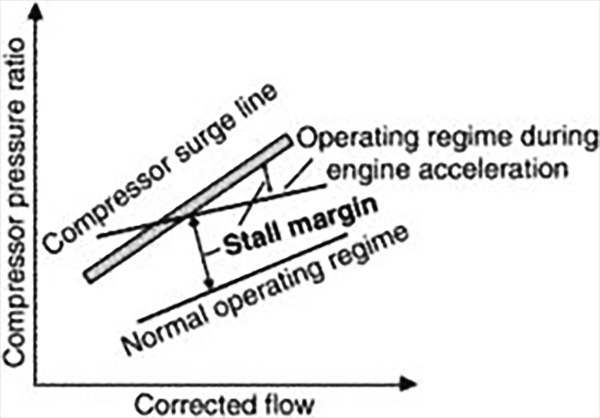Stall Margin
Jump to navigation
Jump to search
 |
In aviation, stall margin refers to the distance, or percentage of lift coefficient, remaining between the current flight condition and the point where the aircraft's wings stall, indicating a loss of lift. Historically, stall margin has been a crucial safety consideration, leading to advancements in stall warning systems and flight control technologies.
Here's a more detailed explanation:
Stall Margin Defined
- The stall margin is the difference between the current angle of attack (the angle at which the wing meets the oncoming airflow) and the critical angle of attack, beyond which the airflow over the wing separates, leading to a stall.
- It essentially represents the "buffer" or safety zone an aircraft has before it enters a stall condition.
- A larger stall margin indicates that the aircraft is flying at a lower angle of attack, closer to the stall point, and a smaller margin means the aircraft is flying at a higher angle of attack, closer to the stall point.
Historical Significance
- Early aircraft lacked sophisticated stall warning systems, making pilots rely on their instincts and experience to avoid stalls.
- As aviation technology advanced, stall warning systems, such as stall strips and aural warnings, were developed to alert pilots of impending stalls.
- The development of flight control systems and automatic stall prevention systems further improved stall margin and safety.
Stall Warning Systems
- Stall warning systems provide pilots with a visual or auditory cue when the aircraft is approaching a stall.
- These systems help pilots avoid exceeding the critical angle of attack and entering a stall.
- Stall strips, for example, are small, thin plates attached to the leading edge of the wing, which are designed to stall before the main wing, providing a warning to the pilot.
Importance of Stall Margin
- Maintaining a sufficient stall margin is crucial for flight safety, especially during maneuvers, landings, and takeoffs.
- Stalls can lead to loss of control and potentially catastrophic accidents.
- Pilots are trained to recognize and recover from stalls, and to maintain adequate stall margin during all phases of flight.
Compressor Stall
- In the context of turbofan engines, a "stall margin" can also refer to the operating range between the design point and the stall point on a compressor performance map.
- A compressor stall occurs when the airflow through the compressor becomes disrupted, potentially leading to a loss of thrust and other issues.
- The distance between the operating line and the stall line on the compressor map represents the compressor's stall margin.
